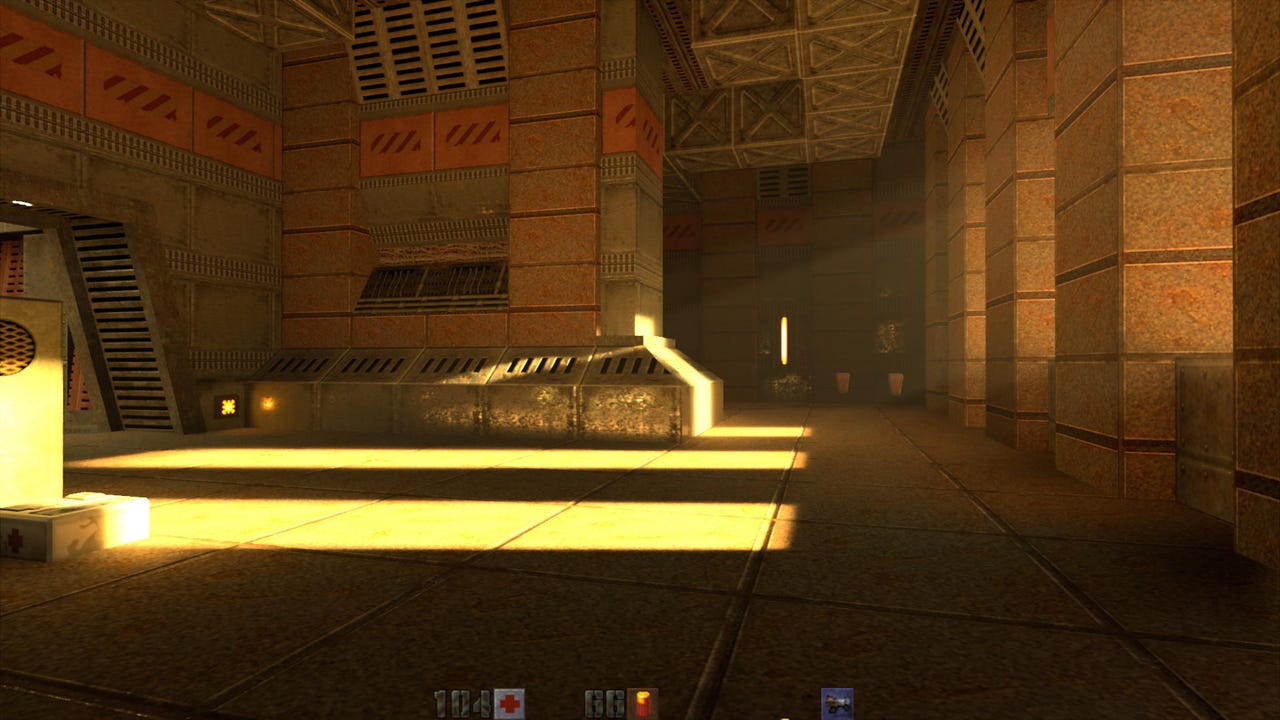The future of graphics is unquestionably AI image generation: Jensen Huang

Quake II with ray tracing
For old-school gamers who fondly remember rocket jumps, there was a point during the GTC keynote address by Nvidia CEO Jensen Huang that would warm the cockles of the heart: An updated version of Quake II to make use of the ray tracing capabilities of the company's RTX GPUs.
The key to this demonstration was denoising, Huang told ZDNet on Tuesday.
"Denoising is basically using AI to infer the missing pixels," he said.
"If I disable the denoising for you yesterday, what it would look like is a black, dark spotty, kind of fuzzy image, but when we turn on denoising, it looks like what you saw yesterday. Incredible."
On Monday, members of the research arm of Nvidia showed off how they can use a neural network to create a high-quality image from a rough sketch, and besides a few boundary issues with different elements, it looked rather realistic.
"It's like a colouring book picture that describes where a tree is, where the sun is, where the sky is," Nvidia vice president of applied deep learning research Bryan Catanzaro said at the time. "And then the neural network is able to fill in all of the detail and texture, and the reflections, shadows, and colours based on what it has learned about real images."
The challenge with this technology, according to Huang, will be how to speed it up to real-time.
"It's very hard -- and the reason for that is because you don't have very much time," he told ZDNet. "You only have about roughly two or three milliseconds to do it -- not one or two seconds."
Responsibility for this increase falls to the Tensor cores used in Nvidia's Turing architecture.
"The Tensor core processor is so fast, and our goal is to now use that Tensor core, to teach it, how to guess, otherwise infer, the missing pixels," Huang said.
"We are doing a lot of work in AI-inferred image-generation. It is unquestionably the future."
Quake II in its original colour and lighting scheme
Earlier on Tuesday, Google announced its Stadia cloud gaming service, a space Nvidia has been playing in for some time with its GeForce-as-a-service offer, GeForce Now. The product is currently in a closed beta with 300,000 users, 15 datacentres, and 1 million further people on a waiting list.
Although he would not be drawn on direct comparisons between the services, Huang told journalists that there are basic laws of physics to deal with.
"The latency, the speed of light matters in the round-trip time of video games," he said. "The round trip time of cloud gaming -- we're the best, GeForce Now is the best in the world -- round trip time is 70ms.
For esports, you would have been shot 10 times, so it's not perfect for esports. Now there are many games, and for some people their framerate is only 30fps .... so for some games, it's fine."
The Nvidia CEO said GeForce Now is actively avoiding trying to become a Netflix of a gaming, due to large gaming franchises and publishers straddling the industry.
"We believe that the video game industry is largely occupied, the best platforms are largely occupied by, call it, five or 10 games -- and these five to 10 games are powerful franchises, they're not going to put it on your store," he said.
"And so our strategy is to leave the economics completely to the publishers, to not get in the way of their relationship with the gamer. Because Blizzard, World of Warcraft, has their gamers, and PUBG has their gamers, League of Legends has their gamers, and the publishers are very, very strong, and they would like to have a great relationship with their gamers, and we would like not to get in the way of that."
Rather, GeForce Now is a way for Nvidia to move beyond its current 200 million userbase, and chase the "billion PC customers, who don't have GeForces" because the economics does not stack up, or their current hardware is limited in some way from high-powered gaming.
With latency being key, Nvidia is looking to get its servers across the globe. In particular, to partner with telcos under the GeForce Now Alliance banner, like SoftBank and LG Uplus which on Monday announced that they would deploy ray tracing capable RTX Servers in Japan and Korea.
Huang added that GeForce Now is expected to be upgraded to RTX hardware in either the third or fourth quarter of the year.
Disclosure: Chris Duckett travelled to GTC in San Jose as a guest of Nvidia
More from GTC 2019
Pascal GeForce GTX cards could get ray tracing with driver update
Superseded architecture to get basic capabilities of beefier stablemate.
Nvidia goes Nano for latest Jetson release
The GPU giant has released a low-powered system for AI tasks.
Nvidia GauGAN takes rough sketches and creates 'photo-realistic' landscape images
Using segmentation maps and a new deep-learning model, GauGAN can create fairly realistic images.
Nvidia unwraps RTX and T4-based hardware and cloud instances
GPU giant unveils new CUDA-X label for its software stack.
Pure Storage, Nvidia, Cisco launch AI hyperscale systems
Pure Storage is expanding its AIRI lineup of systems for artificial intelligence and machine learning workloads.
